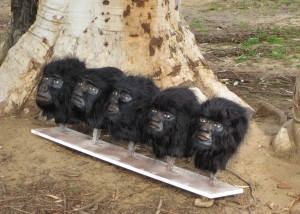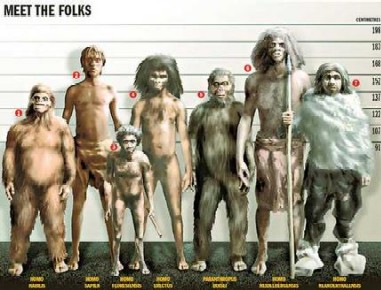
January 28, 2011
I penned some remarks on this subject five years ago. It appears to be time to have it resurface, recombined, as some people are beginning again to lose track of what the big hairy gals and guys have traditionally been called.

The late Kelly McGillis of Canada once asked me on a yahoolist, “What is the plural of Sasquatch?”
To which I replied: “The plural and singular of Sasquatch and Bigfoot are Sasquatch and Bigfoot.
“More than one Abominable Snowman and Yeti are Abominable Snowmen and Yetis.”
Please avoid letting me hear “Sasquatches”!
🙂
No, no, no “Bigfeet” allowed in here.

Some nouns, particularly the names of animals and fish, have the same form in singular and plural. Historically and grammatically correct is the word “Bigfoot” for singular and plural, just as “sheep” means one sheep and two or more sheep.
There are a number of animals that have the same singular and plural form, for example:
antelope – antelope
buffalo – buffalo
bison – bison
mink – mink
otter – otter
bass – bass
deer – deer
moose – moose
swine – swine
pike – pike
trout – trout
goldfish – goldfish
species – species
sheep – sheep
The singular and plural use of “fish – fish” is tricky, however. If you have one type of fish, you have many fish in a school, a bowl, or a pond, for example. If you have a tank full of a variety of species of fish, you have an aquarium full of several fishes.
Within cryptozoology, North American hominoid cryptids typically follow the same irregular plural rule as the above animal words, including:
Bigfoot – Bigfoot
Sasquatch – Sasquatch
Momo – Momo
There are other cryptid names that also follow this pattern, such as:
Mothman – Mothman
Nessie – Nessie
Cassie – Cassie
Tessie – Tessie
Champ – Champ
You can usually immediately tell the articles and books that are written by those people who are unfamiliar with the field of cryptozoology, Bigfoot studies, hominology, and Sasquatch pursuit by their use of such incorrect and uncomfortable plural forms such as “Bigfoots,” “Bigfeet,” “Bigfeets,” “Sasquatches,” and “Big Feet.” All are incorrect, based on common grammatical usage and practice in our field, which follows rules as with the above irregular plural forms, often seen applied to animals.

Plural forms, nevertheless, do follow other common usage rules among some cryptids, for example, singular – plural
Yeti – Yeti or Yetis
Abominable Snowman – Abominable Snowmen or Abominable Snowpeople
Loch Ness Monster – Loch Ness Monster or Loch Ness Monsters
The conforming of practice as applied by native speakers is evolving when its translation into common English usage may be in flux. For example, while one Yowie may be seen, it is fairly common to talk about two or more Yowies. However, presently, use of the plural from of Yeren is still confusing. Is more than one Chinese Wildman called two or more Yeren or two or more Yerens? Thusfar, the preferred form has been without the “s” as in, “He was hot on the track of the three Yeren seen down by the stream.”

The International Society of Cryptozoology established a “manual of style” for the use of capitalization among cryptids, by the way, which I have been using and reproducing in my books, for years. Even though the ISC is defunct, the style lives on and continues in practice.
Here is what I have written on this subject in my books, combining below what I have written on various cryptids:
The style of this work and the use of capitalization for the undiscovered cryptids under discussion (e.g., Bigfoot, Yeti, Loch Ness Monster, Ogopogo, Nahuelito, Bunyip), follows the “manual of style” that was adopted by the International Society of Cryptozoology’s editor, Richard Greenwell, and the ISC scientific peer-reviewed journal, Cryptozoology. Greenwell details the proper capitalization of the cryptozoological names, before and after discovery, in a footnote in Cryptozoology, Vol. 5 (1986), page 101. His formalization of this matter is furthermore based on what occurs in systematic zoology, firm ground indeed.
Greenwell is very clear in his example:
Native name: okapi;
Western name for presumed, undiscovered animal: Okapi;
Common name after discovery and acceptance: okapi.
For our extended use, this translates into:
Native name: yet-teh or yeti;
Western name for presumed, undiscovered animal: Yeti;
Common name after discovery and acceptance: yeti.
Native name: oh-mah,.
Western name for presumed, undiscovered animal: Bigfoot;
Common name after discovery and acceptance: bigfoot.
Native name: nahuelito;
Western name for presumed, undiscovered animal: Nahuelito;
Common name after discovery and acceptance: nahuelito.
and
Native name: naitaka;
Western name for presumed, undiscovered animal: Ogopogo;
Common name after discovery and acceptance: ogopogo.
Therefore, as Lake Monster, Sea Serpent, Nessie, Bigfoot, Yeti, and related forms all have not been technically “accepted” by systematic zoology, as of this date, the capitalized form will be employed.
In terms of the plural form of the above words and the capitalization of cryptid names, I follow these rules in a strict fashion to give a common application of this rule to my written work.
So if you hear or read of someone saying “Bigfeet,” you know they probably don’t know what they are talking about in terms of Sasquatch and other matters of cryptozoology.

This caused a great deal of discussion on Cryptomundo, and I had to write some more on this.
Roger Knights, the intellectually-aware Bigfoot correspondent to many, has followed a comment to my original “Bigfoot, Not Bigfeet” posting five years ago, which deserves to be noted again. He writes:
The Bords were as knowledgeable as anyone, and they used “Bigfeet” as the plural in their Casebook, and retained that usage in the version republished last year. (E.g., in the title of Ch. 7, on p. 121.)…A much better indication of a natural (unaffected) plural is the case of the Blackfoot tribe of Indians. The natural tendency of English-speakers is to refer to a group of them as Blackfeet…. I Googled and found, near the top of the list, an informational website that regularly used phrases like, “The Blackfeet used dogs to drag travois,” etc. If Blackfoot/Blackfeet, then Bigfoot/Bigfeet.
Insistence on avoiding a plural form that comes naturally to the English-speaking population is what might lead them into the error of thinking that only one of the critter exists.
End of Knight’s comment.
Nothing comes so naturally to humans as an examination of their own being.

Okay, thusfar we have Ivan T. Sanderson, from Scotland, cleverly using “Bigfeet” as the chapter title (“The Appearance of Bigfeet”) in his 1961 book, and the Bords, like Sanderson, also from the U.K. (Wales), copycating him by using “Bigfeet” as a chapter title (“Phantom Bigfeet…”) in their 1982 book, and yes, now in their 2005 reprint, Bigfoot Casebook Updated. (BTW, in the modern scanning-based publication of out-of-print Bigfoot books, it is more trouble than it is worth, financially, to change words like “Bigfeet” found embedded in the text of old volumes being reprinted.)
I’m North American (and even a bit Native American), and frankly, “Bigfeet” sounds too strange for my ears and won’t be coming out of my pen or computer keyboard, unless I am convinced by more compelling arguments. I’m not yet so inclined, to date, by anything I’ve heard.
The Blackfoot/Blackfeet debating point, for example, does not fly. The precedent of the Blackfoot and Blackfeet cannot be used to justify the use of “Bigfeet” for more than one Bigfoot.
Blackfeet and Blackfoot are two names for different groups of Indians. The southernmost group of the Blackfoot Confederacy are technically called the “Blackfeet” and are the “Piegans” or “Pikuni” branch of these Natives, located in western Montana.
The posting at Cryptomundo about “Blackfeet Bigfoot,” for example, are about these group’s Montana sightings. The Pikuni are always referred to by the use of the seemingly plural form “Blackfeet.”
Meanwhile, the two other branches of the Blackfoot Confederacy are the “Siksika” and the “Kainah” (or “Blood”) and these residents of Canada are always referred to by the use of the visually and seemingly singular term “Blackfoot.” Thus you actually have two different groups of the Blackfoot Confederacy up north calling themselves “Blackfoot,” alone or in multiple situations.
Therefore, many Blackfoot are not always Blackfeet. It depends on where they live. In Montana, one individual in the Pikuna group is a Blackfeet. In Canada, a group of Siksika are Blackfoot.
Sorry, but I feel Roger Knights is confusing the names that people have given to themselves, as Native Americans and Native Canadians, which are their preferred names, and tried to apply it to our cryptid name-discussion here. But it is apples and oranges.
However, I tend to agree wholeheartedly with something that Roger Knights said earlier in this discussion, elsewhere: “I think violating the usage established for ‘foot/feet’ serves mainly as a sort of marker or ‘shibboleth’ of insider-hood at present.”
Or as I mentioned too, as Michael Taylor, San Francisco Chronicle staff writer, wrote in 1999: “Cognoscenti rarely use the plural ‘Bigfeet’.”
I’ll still go with my notion that anyone calling more than one Bigfoot with the silly-sounding name “Bigfeet” clues me into people that are not close to our field of study, in more ways than one.

This exhibit at McMaster Art Gallery was entitled “Lady Sasquatches.” I rest my case.
Indeed, I have always felt that if I hear or read of someone saying “Bigfeet,” or “sasquatches,” I figured they probably didn’t know what they were talking about in terms of Bigfoot, Sasquatch and other matters of cryptozoology.
Thus, it is has become common practice to use “Bigfoot,” “Yeti,” and “Sasquatch,” even today, and it, frankly, is incorrect to use “bigfoot,” “yeti,” and “sasquatch,” for example, at this present time.
Before Western science verification, it was the Okapi in the West, and now it is the okapi.
To which, Brian Chapman, a few years ago on an email group list, noted I signed my comment “Loren,” and he quipped,
Shouldn’t that be “loren”?
About Loren Coleman
Loren Coleman is one of the world’s leading cryptozoologists, some say “the” leading living cryptozoologist. Certainly, he is acknowledged as the current living American researcher and writer who has most popularized cryptozoology in the late 20th and early 21st centuries.
Starting his fieldwork and investigations in 1960, after traveling and trekking extensively in pursuit of cryptozoological mysteries, Coleman began writing to share his experiences in 1969. An honorary member of Ivan T. Sanderson’s Society for the Investigation of the Unexplained in the 1970s, Coleman has been bestowed with similar honorary memberships of the North Idaho College Cryptozoology Club in 1983, and in subsequent years, that of the British Columbia Scientific Cryptozoology Club, CryptoSafari International, and other international organizations. He was also a Life Member and Benefactor of the International Society of Cryptozoology (now-defunct).
Loren Coleman’s daily blog, as a member of the Cryptomundo Team, served as an ongoing avenue of communication for the ever-growing body of cryptozoo news from 2005 through 2013. He returned as an infrequent contributor beginning Halloween week of 2015.
Coleman is the founder in 2003, and current director of the International Cryptozoology Museum in Portland, Maine.
Filed under Bigfoot, Books, Conspiracies, Cryptomundo Exclusive, Cryptotourism, CryptoZoo News, Cryptozoologists, Cryptozoology, Media Appearances, Men in Cryptozoology, Pop Culture, Public Forum, Reviews, Sasquatch, Skeptical Discussions, Twilight Language, Women in Cryptozoology